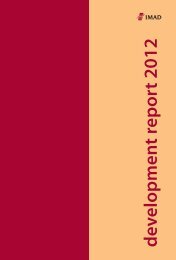Institutional Change in Old Industrial Areas – Lessons for ... - UMAR
Institutional Change in Old Industrial Areas – Lessons for ... - UMAR
Institutional Change in Old Industrial Areas – Lessons for ... - UMAR
You also want an ePaper? Increase the reach of your titles
YUMPU automatically turns print PDFs into web optimized ePapers that Google loves.
spatial consequences (Ell<strong>in</strong>ger 1977). This behaviour is dependent of the age of the<br />
firms. In the early stage, firms are not limited <strong>in</strong> regard to their location decision. In<br />
the early stages of growth, the comb<strong>in</strong>ation of super profit and of imperfect<br />
competition (because of exist<strong>in</strong>g limits to capital mobility and because of price<br />
<strong>in</strong>elastic demand) allows <strong>for</strong> successful development without consideration of<br />
regional differences <strong>in</strong> costs of location (Markusen, 1985). This is the consequence<br />
of the specific decision-mak<strong>in</strong>g behaviour of these firms: they are "adaptable", i.e.<br />
they are either <strong>in</strong>novators themselves or quickly adopt <strong>in</strong>novations; they decide to<br />
start production soon after a major <strong>in</strong>novation. In later stages this behaviour<br />
changes: the firms become "adaptive" - they adjust to their economic and regional<br />
environment. Their behaviour becomes "locationally decisive" <strong>in</strong> locational costs.<br />
Both <strong>for</strong>ms of entrepreneural behaviour - the adaptable and the adaptive - thus<br />
follow a temporal sequence; the spatial consequences are part of an evolutionary<br />
process. Yet the basic freedom of location <strong>in</strong> the early phase is restricted <strong>in</strong> real<br />
space and <strong>in</strong> real time - the resources which are necessary <strong>for</strong> adaptable behaviour<br />
cannot be attracted everywhere. From this there results an <strong>in</strong>terrelationship between<br />
the locational needs of <strong>in</strong>novative firms and the manifold factors of production which<br />
are necessary <strong>for</strong> adaptable behaviour. On the other hand, the distribution of<br />
regional supplies of such factors is not <strong>in</strong>dependent of the distribution of such firms -<br />
the location and the situation of many factors can be <strong>in</strong>fluenced by the decisions of<br />
firms <strong>in</strong> their <strong>in</strong>novative stage.<br />
These different k<strong>in</strong>ds of behaviour demand certa<strong>in</strong> economic environments with<br />
special resources. The difference <strong>in</strong> regional economic potential there<strong>for</strong>e resides <strong>in</strong><br />
these specific factors which are characteristic of each evolutionary stage. At the<br />
same time, they correspond to the different behaviour and the adjustment<br />
per<strong>for</strong>mances which these supplies of factors allow to be produced - the regional<br />
distribution of factors of production depends <strong>in</strong> the long run on the behaviour of a<br />
region's firms. <strong>Old</strong> <strong>in</strong>dustrial areas accord<strong>in</strong>gly are regions with an <strong>in</strong>sufficient<br />
adjustment per<strong>for</strong>mance, deficient <strong>in</strong> adaptation, which results <strong>in</strong> negative selection<br />
either because an "over adjustment" led to a dead end of the evolution or because a<br />
too rapid change of the environment (to which there was no timely reaction)<br />
exceeded the potential <strong>for</strong> adjustment; "non-adapted" regions stagnate, they have<br />
8
















